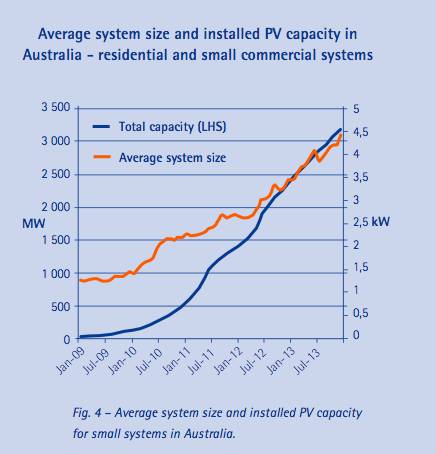This graph below caught our eye – showing not just the increase in installed capacity of rooftop solar PV in Australia in recent years, but also the increase in individual household system size.
This data – included in the International Energy Agency’s Photovoltaic Systems Program annual report – is taken to the end of 2013, although recent figures show that the accumulated total is now 3.4GW on around 1.4 million homes.
A couple of key points emerge. The first is that the size of residential rooftop solar PV systems increased from 1kW in 2009 to 4kW in 2013. In just the last three years, the size of the system has more than doubled, and the total capacity has risen three-fold.
The report says that around 850MW of solar PV was installed in 2013, mainly small- scale residential systems. Despite increased restrictions on PV power exports to the grid, and low or zero rates now paid for exported power, solar PV system sizes have continued to increase.
The second major point is that rooftop solar PV now accounts for around 5% of electricity capacity and 2% of electricity generation in Australia. As we have seen, this is eating into the earnings of incumbent generators and is one of the main reasons they want support for rooftop solar to be removed.
The report notes that module prices continued to drop from $1.30 per watt in 2012 to around 75c/watt and installed prices for small residential systems dropped from an average of around $3/watt to around $2.50 watt.
“With continued increases in grid electricity prices, PV is a cost effective option for homeowners across Australia and is of increasing interest to the commercial sector.”
However, the report warned that development of the commercial market is currently hampered by the lack of standardised procedures or rights to connect, while the residential market may be impacted by restrictions, fees and other disincentives. “If imposed, these could result in further market contraction in 2014.”
It also noted that there is increasing customer interest in on-site storage.
“Although not yet cost effective for most customers, a market for storage is already developing. This trend could exacerbate issues faced by incumbent electricity sector businesses, even if it offers a means to manage supply intermittency and peak demand, since it would facilitate the installation of larger PV systems and may also see a trend to self-sufficiency and disconnection of customers from main grids.”











